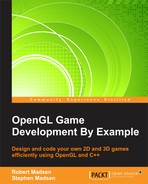Welcome to OpenGL Game Development Blueprints! We are excited that you chose this book as your guide to both OpenGL and game development. This section will provide you with a brief preview of each chapter, followed by the technologies that are required to complete the work that is presented in the book. Finally, we will discuss the target audience for this book so that you will know whether this book is right for you.
Chapter 1, Building the Foundation, guides you through creating the code framework for the game. Games use a particular structure that is known as the game loop. By the end of this chapter, you will understand and have created the game loop for the game as well as initialized the required OpenGL elements.
Chapter 2, Your Point of View, introduces you to the first project in the book—creating a 2D platform game. The first step in this project will be to define the type of view that is required by OpenGL, and render the background of the game.
Chapter 3, A Matter of Character, covers the creation of sprites that move on the screen. 2D frame-based animations are the core of any 2D game, and you will learn how to create simple graphics and render them to the screen.
Chapter 4, Control Freak, teaches you how to build an input system that will allow you to control the main character and other aspects of the game. You will also create a basic user interface that allows you to start the game and navigate to various options.
Chapter 5, Hit and Run, covers collision detection. You will learn how to stop the character from falling through the ground, how to land on objects, and how to detect whether enemies have hit you or have been hit by player weapons. By the end of this chapter, you will be able to play the game for the first time.
Chapter 6, Polishing the Silver, covers the topics that make a game presentable (but are often overlooked by novice developers). You will learn how to implement a scoring system, game over and game won scenarios, and simple level progression. This chapter will conclude the 2D project of the book.
Chapter 7, Audio Adrenaline, guides you through implementing sound effects and music in the game. We will provide links to some audio files that you can use in your game.
Chapter 8, Expanding Your Horizons, will start the second project of the book—a 3D first-person space shooter. At the end of this chapter you will have created a new project, starting the framework for a 3D game.
Chapter 9, Super Models, introduces you to the concepts of 3D art and modeling, and then guides you through the process of loading 3D models into the game environment. Although you will be able try your hand at creating a 3D model, the resources that are required for the game will be provided online.
Chapter 10, Expanding Space, expands on many of the concepts that were covered in the 2D segment of the book and applies them to a 3D world. Movement and collision detection are revamped to take this new dimension into consideration. An input scheme to move in 3D space is implemented. By the end of this chapter, you will be able to control a 3D model in 3D space.
Chapter 11, Heads Up, guides you through creating a 2D user interface on top of the 3D world. You will create a menu system to start and end the game, as well as a heads-up-display (HUD) that shows the score and stats in game. By the end of this chapter, you will have created a playable 3D shooter game.
Chapter 12, Conquer the Universe, introduces you to some of the more advanced concepts that were beyond the scope of the book, and it gives you some direction to advance your skills.
